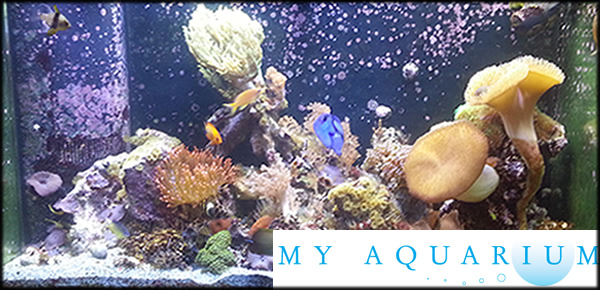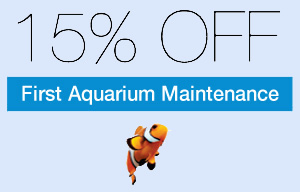How To Setup A Freshwater Fish Only Aquarium.
The most typical home aquarium is a simple freshwater fish only aquarium. Before the dedicated aquarists decided to venture into the world of CO2 injected planted aquariums, aquariums depicting specific natural habitats, mixed reef tanks, or any kind of salt water tank; they almost always start with a simple fish only freshwater aquarium.
A simple fish only freshwater aquarium takes the least amount of research, knowledge, or expertise to set up or maintain compared to any other aquarium choices. Just cause a fish only freshwater tank is simple doesn't mean you should just buy yourself a glass box and go to the local pet shop and pick whichever fish you think are prettiest and throw them in some water.
Fish are pets and some research and thought should be put into their environment to ensure they have what they need to feel as much at home as possible. Rest assured that there are many forgiving freshwater fish species that can thrive in very simple and low tech environments.
A fish only freshwater tank is very economical and inexpensive to set up and to run in comparison to the more technical and in depth types of aquariums. There are still some things that should be taken into consideration even in this simplest of tanks; you will need adequate filtration, the right substrate, a fish hiding place or decor, clean water at the right temperature, good aeration, and you will need to ensure you don't mix species that shouldn't be housed together.
One way to ensure you get everything you need is to purchase an All In One Aquarium Kit that will include the tank, light, filter, heater, substrate, decorations, and proper chemicals. If you decide to go with an all in one set up you will still need to buy compatible fish after it is set up.
If you would prefer to purchase these components one at a time that is also fine, lets go through them one by one.
The Aquarium Itself: For the most part deciding which aquarium to choose is a personal preference but their are a few details you may want to take into consideration for your fish. Primarily you need to consider the size and shape of the aquarium versus the amount of fish you wish to keep in it.
How many fish you want to keep and what size they grow to should be the primary contributing factor in how big an aquarium you decide to purchase, remember that the surface area at the top is the deciding factor, not how many gallons the tank holds.
Don't let the size of the fish when you buy them deceive you, some fish can be purchased at very small sizes and then grow too large for your aquarium to handle. Keep in mind the size your fish will be when reaching full adult maturity when buying them. Guppies will stay small, reaching a mature size of 2.5 inches while the Oscar will reach over 12 inches long.
Here are some simple guidelines; for every 12 square inches of water at the surface of your freshwater tank you can add up to 1 inch of fish. So if you have a standard 55 gallon aquarium (48' by 12' = 576' / 12 = 48') you will want no more than 48 inches of fish in your tank. Remember that these are not strict guidelines Just use good judgment when deciding how to maximize the full potential of your tank space.
Aquarium Substrate: The substrate is the gravel or sand that layers the bottom of the tank. The substrate not only provides you with a good looking aquarium but also provides a good place for beneficial bacteria to grow and thrive. Also with no substrate the reflective glass at the bottom of the aquarium can disorient your fish.
There are many types of substrate. Gravel is the most common in a freshwater tank and comes in many sizes. A good depth of gravel for a fish only freshwater tank is about 1.5 inches but depth is really a personal preference in a simple fish only aquarium.
Sand can be appealing but you should also realize it can be more difficult to siphon and clean and can be more likely to cloud the tank. My personal favorite in a freshwater tank is fine gravel in a natural color, but if you want red or blue that is also up to you.
Aquarium Lighting: In a fish only aquarium lighting is really up to you the viewer. While planted and reef tanks require high intensity light for photosynthesis there are no such needs in a fish only tank. Getting overpowered lights that are designed to grow plants or coral in a fish only tank is a waste of money, electricity, and will likely cause nuisance algae to grow. I recommend a simple normal output low wattage florescent light.
In your freshwater fish only tank your lights only purpose is for you. It supplies a nice ambiance for you tank as well as simply providing light for you to see. Lights come in many different temperatures that range from bright white to a deep blue, you can also add optional LED moon lighting to simulate a night time feel overnight.
Aquarium Heater: Temperature is very important to the well being of your fish. Some fish need different temperatures than others but most warm water tropical fish require a similar temperature between 72-80F.
More important than the specific temperature you set the aquarium to is that you keep the the temperature stable and consistent. The best way to keep a warm stable temperature in a freshwater tank with low lighting is with a simple aquarium heater.
Heaters come in as low as 25 watts for heating a small 5 gallon tank up to 300 watts for heating up to 75 gallons of water. Titanium heaters are available for any tank that is larger than 75 gallons for sufficient and accurate heating. You can also choose to use several smaller heaters rather than a single big heater which can have the advantage of having a back up in case one breaks.
Aquarium Decorations: Plants, backgrounds, and little floating scuba divers. How you decorate your aquarium is mostly up to your own design preference but you should keep in mind that you need to provide your fish with some sort of hiding place.
Fish are naturally shy and timid creatures, add a number of fake plants, driftwood, shipwrecks, or pagodas for your fish to feel like they have some habitat to swim in or around to evade danger.
Choosing an aquarium background is simply a matter of preference. The main purpose of a background is to hide unsightly wires and filter tubes that may run along the back side of the aquarium.
Backgrounds come with different scenery or colors but what is looks like will purely depend on what is pleasing to your eye. Some people like to see planted, rocky backgrounds to add more depth to the underwater scene, while others like to display a solid blue background to let the striking colors of the fish speak for themselves, the fish will never notice either way.
Aquarium Filtration: There are countless filtration options and most will work for your freshwater fish only aquarium. The purpose of a filter is to clear debris and harmful chemicals from the aquarium, and also to re-oxygenate the water. You will want to choose a filter size according to the amount of water that your aquarium can hold.
The three types of filtration include mechanical, biological and chemical. Most store bought filtration systems will provide all three types of filtration. For a simple fish only freshwater aquarium I would recommend a typical hang on back trickle filter or for and even better filter you can buy a canister filter that will fit below the aquarium. Any filter you buy will be rated for a certain number of gallons, you can choose any filter that is rated for your size tank or bigger.
As the water gets pushed out of these multifunctional filters it is flows back onto the surface of the aquarium water. This is where the gaseous exchange of oxygen gets replenished into the tank once again. The key is to have movement on the surface of the water so that the atmospheric oxygen can diffuse back into it. The more surface area of water exposed the better. That is why it is more practical to have a low wide tank instead of a tall narrow one.
Choosing Your Fish: Once your tank is set up, full, and running you are going to need to choose the right fish. There are two main types of freshwater species, there are cold water and tropical. Tropical fish live in relatively warm, freshwater and can be among the easiest to care for. Cold water fish like Goldfish come from fresh waters that are colder than regular tropical fish can handle.
Different fish have different needs and one water parameter may be ideal for one type of fish but can possibly be lethal towards another type. Drastic changes to living conditions can place the life of a fish in peril and may result in declined health or death. Some fish that are bred and raised in the aquatic retail industry have become less sensitive to differentiated conditions yet not totally immune.
When choosing types of fish you must really understand how to first take care of their needs. Live bearers such as Guppies and Platys need plenty of plants to hide in especially when giving birth to their young. Flounders need a sandy substrate in order to camouflage themselves enough to hunt for food. Loaches need plenty of free swimming space to compliment their playful behaviors. Different species of fish have their own unique needs; the key is to find fish that can coexist in an aquarium where all of their requirements can be met.
Do some research in the species section of this site and other sites and have the sales person recommend which species of Fish are ideal for beginner aquarists. Most likely, if you have never had an aquarium before and you want something somewhat low maintenance.
They may recommend that you start with a Gourami or Guppy because they are hearty fish that are fairly inexpensive and easy to care for. Another reason they might recommend the Guppy or Gourami is that they are relatively small fish who produce less waste. An inexperienced aquarist may do great taking care of larger fish such as Cichlids that are very hearty but the maintenance is more time consuming due to the amount of waste produced by these big eaters.
Overall fish only freshwater tanks are very easy to care for and inexpensive, they are a great way to start yourself off in the aquarium hobby and really decide if you like it and want to move onto something more advanced and difficult. Fish keeping can be a wonderful and interesting hobby that can last a lifetime, I wish you all the luck in the world.


